In the distance, you can see these huge loading machines, very similar to each other and fulfilling the same function; be combined vertical and horizontal transport equipment, however, when looking at them carefully, it can be verified that in fact, the types of tower cranes are very different from each other.
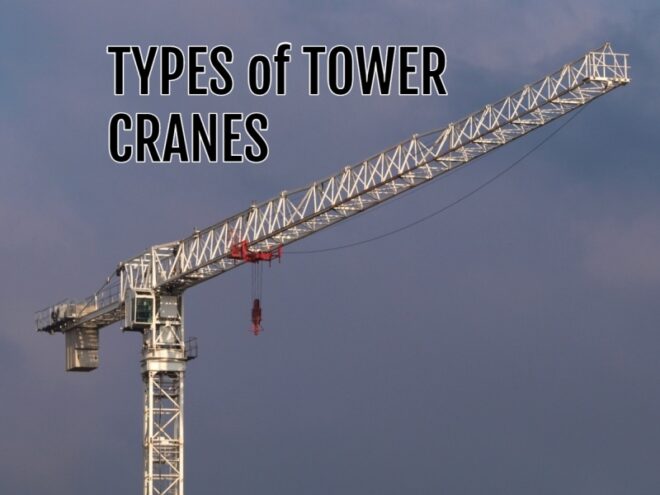
Types of construction cranes
Classification of tower cranes: How many types of tower cranes are there and what are they? Due to the reach and height, they can develop they are used a lot in the construction of tall structures. Tower cranes can be classified according to:
The way it is assembled
Automatic Crane
Automatic Crane (GA): It is the one that comes with its folded tower and boom, with the separated cable runs, with their counterweights generally placed. You just have to level it, deploy it and at the time it is armed, it can be calibrated.
Tower crane: It is one that is assembled by sections, helped in its first part by a motorcycle crane. Then we continue adding cloths through an assembly operation.
Mobile Tower Crane
It is the combination of the previous two and in addition, you can add some sections. The use of this type of cranes in the construction of small heights and open spaces has already become very popular.
Generally, small capacity models have been used. Nowadays, however, there is a wide range that includes cranes up to 140m / t.
These cranes are easily portable since they can be sent as compact units in a trailer, with their counterweights, even large capacity ones.
This type of cranes has incorporated the possibility of climbing to achieve greater heights of employment, so that the advantages of a rapid movement from one place to another, is added the possibility of using them in higher constructions.
The development trends of these cranes have been aimed at achieving greater possibilities of installation and assembly that can be summarized in the following:
- Easily save obstacles such as antennas, chimneys, and adjacent buildings, by using the crane by raising the boom at an angle of 45º.
- Reduce the radius of rotation of the base by modifying the design of the base and the counterweights.
- Allow the assembly of them boom to be carried out in increasingly reduced spaces by means of joints and folding of the same.
- Achieve higher heights through simple and fast climbing processes.
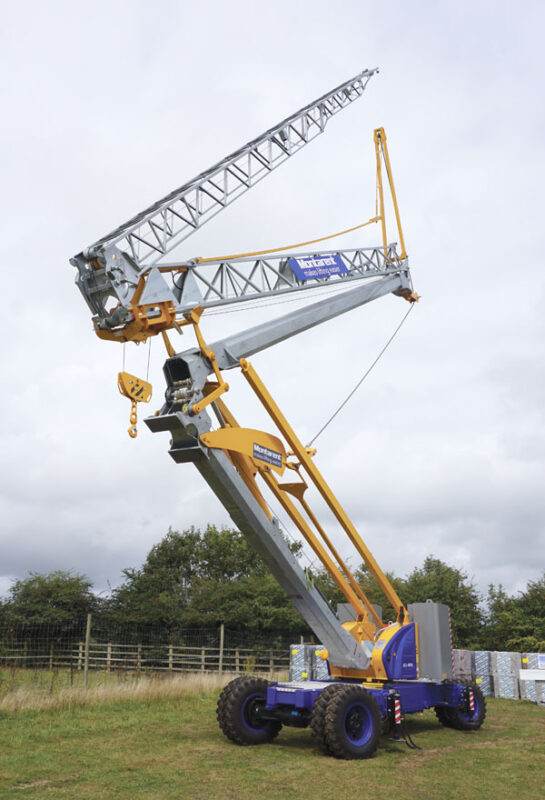
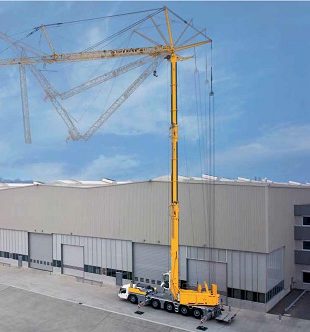
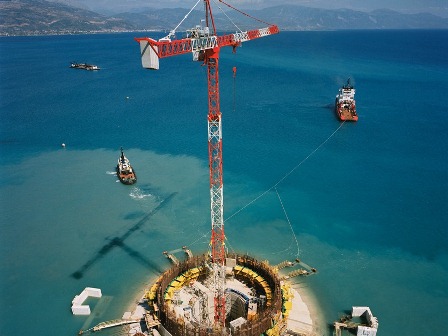
For the form of support of the crane
Rolling Tower
It is the crane model most used for the construction of blocks of apartments and in buildings of isolated towers, they allow to move the crane with a load on a previously studied and installed on-site road. Given the importance of the routes of translation for a good performance of these teams, it is convenient to respect all the security measures that are adopted in these cases.
Fixed Tower Crane
In this version, the crane is located static at a point, on a chassis and distributed in the circle area encompassed by the boom. The assembly of this lifting equipment on site can be through the following procedures:
The embedding of a concrete block of dimensions according to the resistance of the ground and the weight of the ballast. Normally this solution is used in those works where the crane chassis cannot be assembled, due to lack of space. In general, its height of autonomy decreases.
On the base chassis, without wheels, resting on a resistant slab, with convenient base ballast.
Bolted the base chassis to some slab or beams of adequate strength. In the case of cranes of climbing version, on their frames or rings conveniently fastened to the floors.
Crane climbing
It is a mounting system that allows the tower crane to increase in height by moving inside the building as it increases in height. All its horizontal and vertical loading efforts are transmitted to the building through supporting structures.
This type of system has a drawback in its disassembly, which is slower because it is done on the terrace of the building, which is generally of variable geometry, in this area you have to anchor the equipment necessary for disassembly, which must be calculated and designed in advance. Nowadays this type of fixed tower crane is little used.
Stationary crane
Crane Tower Anchored to the Building or Braced:
When a tower crane exceeds its rolling height determined by its stability, in work and out of service, exposed to excessive wind speed, it is necessary to secure it, anchor it, if the crane is close to a building, and braking it by means of winds if The crane is in a clear work.
Tower crane truck
This type of crane, a combination of an automobile crane and a tower crane, represents a practical alternative to the conventional truck crane since the advantage of the higher starting height of the boom is added to the same speed of transfer between different work points. that has the incorporation of the crane.
By the shape of the Crane boom
Horizontal boom tower
Currently, tower cranes of 4000 m / t are available, which can operate with freestanding heights of up to 300 m. A crane of this size can lift 37 tons at a radius of 80 m and its maximum load is 80 tons. Even modern engineering allows installing a second auxiliary crane on the counter jib of these giant cranes.
Tower crane with articulated boom
This type of crane allows varying the geometry of the use of the boom, being able to be used in a horizontal position, obtuse angle, and straight.
This characteristic makes them especially suitable for certain constructions, such as cooling towers and TV towers. Its design allows maximum height and a smaller number of bracing for similar towers.

Tower crane with a folding boom
This type of crane is especially suitable for use in narrow areas and in areas where there can be no interference between installed cranes. The possibility of moving the jib between angles of 15º and 70º allows clearing the obstacles of its radius of action in a very simple way.
Concreting towers
As a variant of the use of interest, this application can be pointed out, since by eliminating the jib and the counter-feather from the standard models, there remains a rotating mobile tower in its upper part.
Adapting to this set a concrete pump, it is possible to unite for the distribution of the concrete, the advantages that concur in the two means employed. Even this variant of use is possible using the crane in the double application, as a tower crane, and as a support for the concrete pump.
City Crane
Crane city “City Crane”:
This type of cranes is being used especially for the construction work in places already built, such as in the renovation of buildings in the old areas of the cities, close blocks to each other, restoration of facades, timbered historic buildings.
Cranes are needed with a technology capable of solving the specific problems of this type of construction and for example are: little space between the building and the street with a very small sidewalk, very narrow streets, mounts to be made in courtyards, elevator shafts or opposite side of the street and this with additional difficulties such as traffic cannot be closed completely or for a very short time, floors with low capacity to support loads, etc.
These cranes are specially designed to be assembled with a very small number of sequences and must offer the following basic characteristics:
- The base that occupies a small space and that is also capable of supporting the loads per corner to which they must be subjected. These bases usually have a cross shape and should be easily convertible into a cart to install on track.
- Towers of the reduced and compact section to allow their installation in very small holes and to save transport space
By the way of Giro
Crane Tower of the basal turn
It is the one in which the turn occurs in the lower part. Its height is limited.
Tow crane Tower top
It is the most frequently used, its rotation occurs at the top and allows to achieve a greater height.
The constant demand for this type of cranes has produced a considerable advance in the techniques of drive and control. The application of display systems in relation to electronic function packages and system solutions has brought with it, new dimensions for performance and safety.
How do cranes get to the top of skyscrapers?
While that’s the most common method, there are actually three ways:
1) the external climbing method, in which the crane -the arm plus its tower- expands upward along the outside of the building.
2) the internal climbing method, in which the crane builds a few floors at a time from the inside and then “jumps” to a higher spot.
3) the “sky crane” method of airlifting in a crane on a helicopter. (Engineers at 1 WTC are using both of the first two methods.)
Cranes and derricks are hoisting machines used to lift and move heavy loads in such places as factories, shipyards and construction sites. Most derricks are stationary while most cranes can move from place to place under their own power. Engineers, however, sometimes use either name to describe the same machine.
-Luffing tower crane.
-A-frame tower crane.
-Flat top tower crane.
-Self-erecting tower crane.
-Portal tower crane.
-Remote control crane.
Hans Liebherr. They invented the very first mobile tower crane, which was, as its name would suggest, a crane that construction companies could move around while still enjoying the benefits of the tower crane. Hans Liebherr helped develop the mobile tower crane in the late 1940s with the help of a team of design engineers.
Tower crane, hoisting machine for lifting heavy loads and transferring them from one place to another, ordinarily over distances of not more than 200 ft (60 m). Cranes have a long reach and can lift loads to great heights.
The maximum load that the crane can lift is 18 metric tons (39,690 pounds), but the crane cannot lift that much weight if the load is positioned at the end of the jib. The closer the load is positioned to the mast, the more weight the crane can lift safely. The 300 tonne-meter rating tells you the relationship.
Generally, when anchored to the ground, a tower crane can’t be much more than 265 feet tall. They can be much taller if they are secured to a building as the building rises. The maximum jib reach is approximately 230 feet, and the maximum weight it can lift is 19.8 tons or 18 metric tons.
Tower Crane Pictures
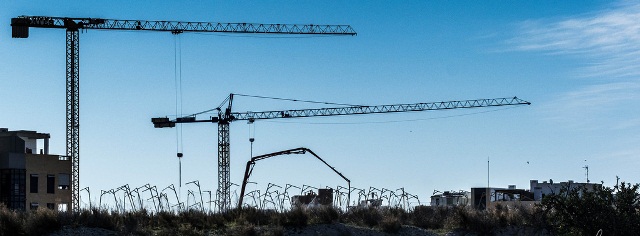
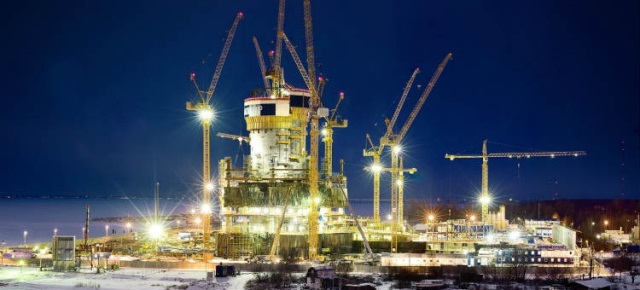
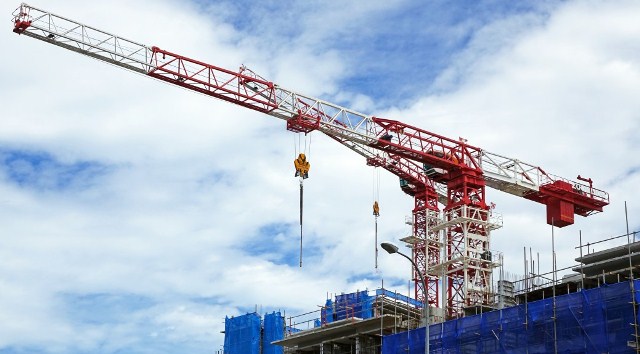

The most read
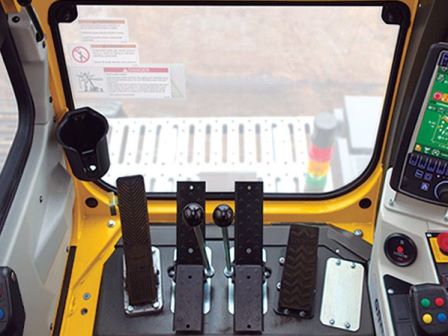
Tower Crane Cab
Cab features include improved seat position and access, a USB port and optional Bluetooth.

Remote Control Tower Crane
Radio remote controls are now standard equipment on most self-erecting tower cranes and are even becoming common in some parts of Europe for a flat-top tower crane.
